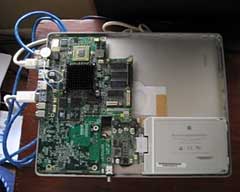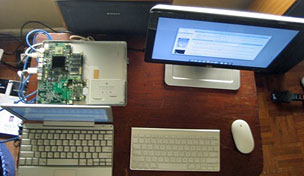My first new computer was an IBM PS/1 given to me by my
grandmother on Christmas of 1992. In the next 12 years I would own a
number of secondhand desktops and laptops, all PCs. Then, in 2005, my
second new computer, the venerable 12" PowerBook, was given to
me by my parents as a gift for finishing an Associates Degree
program.
It was my first Mac, and I decided on it because I was tired of
rebooting from Linux into Windows to do video editing. Mac OS X
"Tiger" would provide me a fine Unix system and robust video
editing.
But this story is about hardware.
Damaged Goods
A couple months into owning my PowerBook, I tripped over the power
cord, and it fell from the kitchen table. Landing flat on the floor
broke its SuperDrive and damaged the hard drive. Replacing the
SuperDrive was quite the endeavor, I found out as I blindly followed
the iFixit.com take-apart guide
without reading through it first.
Video RAM errors sequestered me to an external display until I
replaced the logic board. Hasty disassembly at some point led me to
breaking a capacitor (or something) off the DC-to-DC board that
interfaces with the battery, so that was replaced as well. A gigabyte
of RAM and a 100 GB 7200 RPM hard drive was installed.
My PowerBook Spawns a Second Computer
 I
attached the old DC-to-DC board to the old logic board and connected it
to an external monitor. I scavenged a power switch button and a DC-in
board from my girlfriend's dead 800 MHz iBook. Google told me
the DC-in board was compatible, and it plugged into the logic board
after some force. I had an extra 256 MB RAM stick from upgrading to
1.25 GB in my main PowerBook. I stuck in small PC heat sink I had atop
the processor. I installed OS X on an external hard drive and
booted the amalgamation of components.
I
attached the old DC-to-DC board to the old logic board and connected it
to an external monitor. I scavenged a power switch button and a DC-in
board from my girlfriend's dead 800 MHz iBook. Google told me
the DC-in board was compatible, and it plugged into the logic board
after some force. I had an extra 256 MB RAM stick from upgrading to
1.25 GB in my main PowerBook. I stuck in small PC heat sink I had atop
the processor. I installed OS X on an external hard drive and
booted the amalgamation of components.
Aside from the DC-in board, to run from an AC adapter instead of
battery, this cobbled together machine possesses the minimum amount of
12" PowerBook hardware needed to run. A battery is not essential, but
the system won't boot without the DC-in board the battery plugs into.
Incidentally, I have two batteries to use with this Frankenstein, one
belonging to the iBook and one that was replaced by the battery recall.
(Was I supposed to be billed if I didn't send that back?)
 I don't
have a USB keyboard, but I have a mouse, so I used it to turn on Screen
Sharing. I connected an ethernet cable and used my main PowerBook to
control the system over the network with Screen Sharing. I paired my
Bluetooth keyboard and mouse with my main PowerBook and became the
owner of a second Macintosh. From the idea's conception to first boot,
I never left the house; it was cool to watch my cardboard box full of
junk boot Mac OS X.
I don't
have a USB keyboard, but I have a mouse, so I used it to turn on Screen
Sharing. I connected an ethernet cable and used my main PowerBook to
control the system over the network with Screen Sharing. I paired my
Bluetooth keyboard and mouse with my main PowerBook and became the
owner of a second Macintosh. From the idea's conception to first boot,
I never left the house; it was cool to watch my cardboard box full of
junk boot Mac OS X.
Present Day
I plan to buy a Bluetooth 'board ($10 including shipping on
eBay) to forego the Screen Sharing rigmarole and connect the
keyboard and mouse directly, and I may splurge on an AirPort Extreme
card.
I am also going give it it's own power adapter. It's currently
sharing one with my main PowerBook, alternating battery charging
sessions. I don't see this as an unnecessary expense, because this
adapter has long needed replacing.
I've offered this thing to my girlfriend several times to replace
her Windows computer, seeing as she's been waiting forever for a
Mac mini revision. She only
responds, "That's not a computer." I'd like to make it one by putting
it in a case of some sort, if anyone has ideas for one email me
cthildreth(at)gmail(dot)com. (She won't accept an NES for a case - I
asked.)
Share your perspective on the Mac by emailing with "My Turn" as your subject.

 I
attached the old DC-to-DC board to the old logic board and connected it
to an external monitor. I scavenged a power switch button and a DC-in
board from my girlfriend's dead
I
attached the old DC-to-DC board to the old logic board and connected it
to an external monitor. I scavenged a power switch button and a DC-in
board from my girlfriend's dead  I don't
have a USB keyboard, but I have a mouse, so I used it to turn on Screen
Sharing. I connected an ethernet cable and used my main PowerBook to
control the system over the network with Screen Sharing. I paired my
Bluetooth keyboard and mouse with my main PowerBook and became the
owner of a second Macintosh. From the idea's conception to first boot,
I never left the house; it was cool to watch my cardboard box full of
junk boot Mac OS X.
I don't
have a USB keyboard, but I have a mouse, so I used it to turn on Screen
Sharing. I connected an ethernet cable and used my main PowerBook to
control the system over the network with Screen Sharing. I paired my
Bluetooth keyboard and mouse with my main PowerBook and became the
owner of a second Macintosh. From the idea's conception to first boot,
I never left the house; it was cool to watch my cardboard box full of
junk boot Mac OS X.
